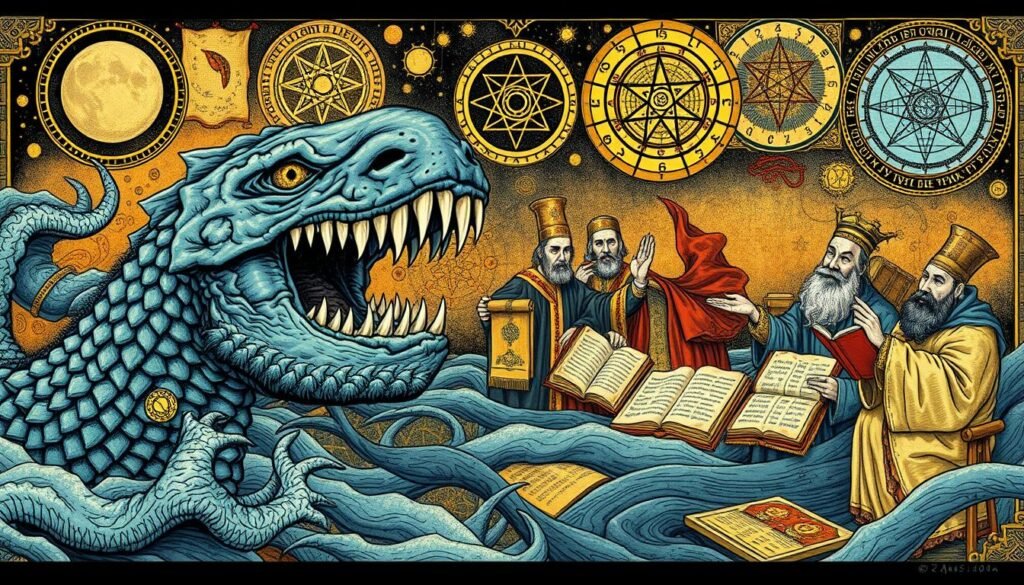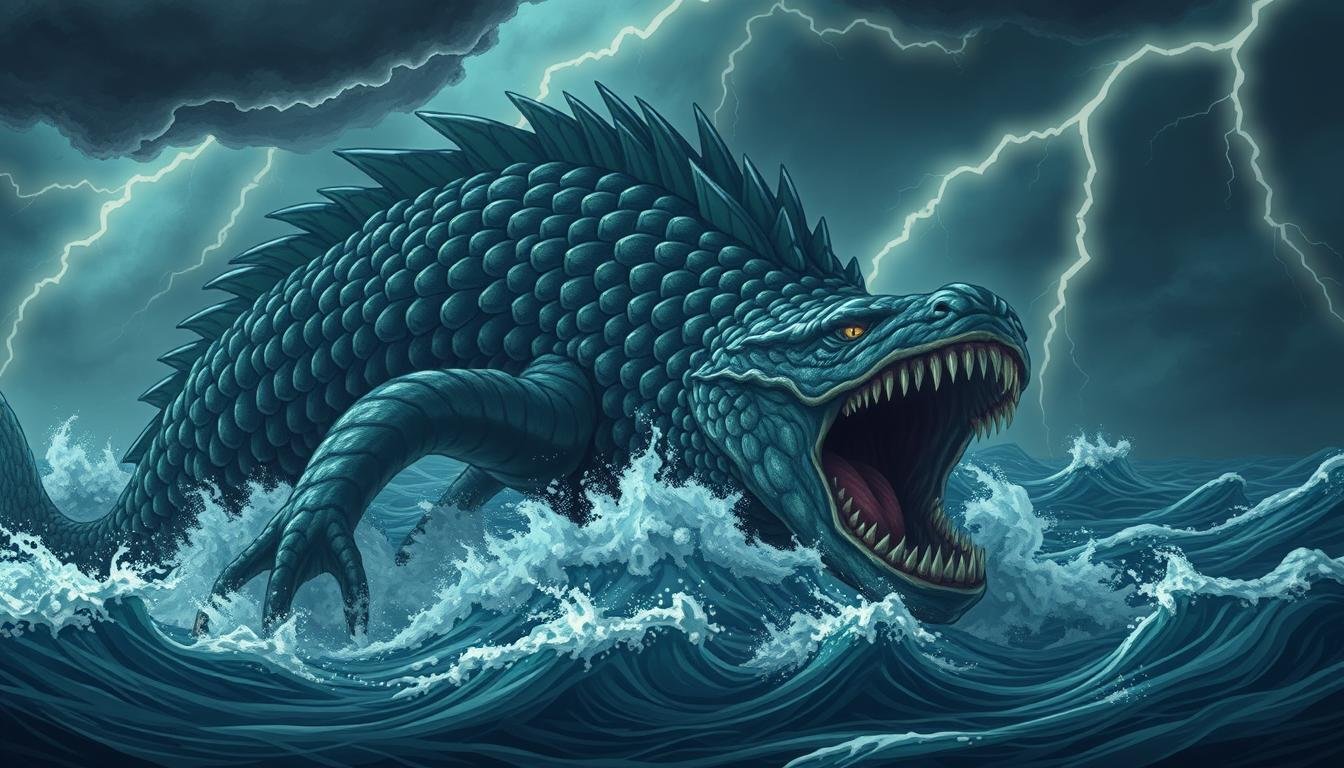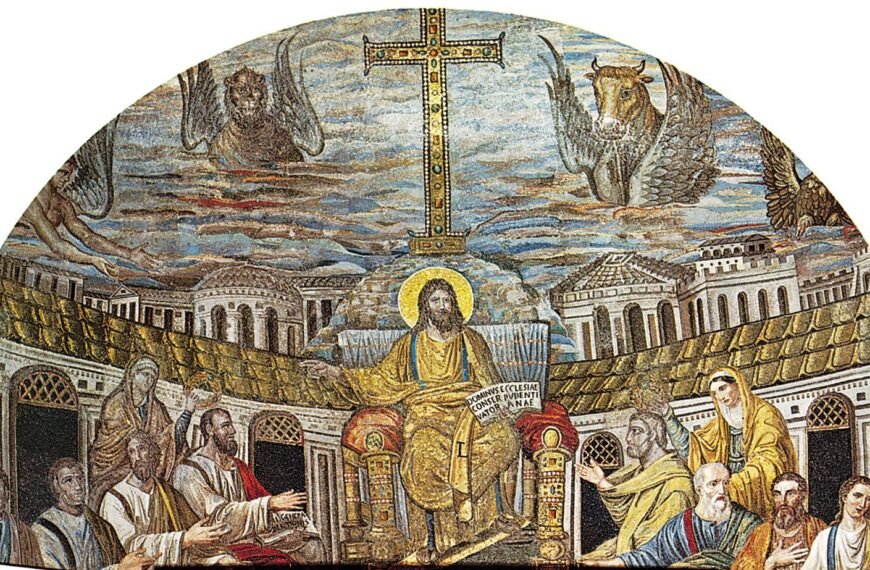Imagine reading the Bible and finding a sea monster that breathes fire. It has armor-like scales and is so big, it’s hard to understand. The leviathan in the bible is not just a biblical sea monster. It shows God’s power and order in the world.
For a long time, people have been fascinated by Leviathan. It appears in Job’s poems, Isaiah’s prophecies, and Revelation’s symbols.
Job 41:19-21 says Leviathan’s breath is like “flaming torches” from its mouth. This makes it seem real. But it’s more than just a story.
It shows Leviathan as chaos, but God’s power can control it. This mix of creature and symbol makes us think about faith and creation today.
Leviathan is seen as a prehistoric beast, a symbol of evil, or both. Its story in Job 40:29 makes us think about our limits. It asks, “Can you catch Leviathan with a fishhook?” This shows we need God’s help.
As we learn more about Leviathan, we see it as a link to old myths and a sign of lasting truths in faith.
What is Leviathan in Biblical Context?
Exploring the leviathan meaning starts with its roots in Hebrew cosmology. This mysterious figure links language and theology. It shows how Leviathan became a symbol of God’s power over chaos.
The term’s journey from ancient texts to modern English shows its lasting impact. It remains a powerful metaphor for overwhelming forces.
Etymology and Origin of the Name Leviathan
The Hebrew term Livyatan comes from a root meaning “coiled” or “twisted.” It suggests a snake-like creature. By the Middle Ages, English used “Leviathan” for huge entities.
This change shows how it evolved from a mythic creature to a cultural symbol.
First Appearances in Ancient Near Eastern Texts
“There go the ships, and Leviathan, which you formed to sport in it.” (Psalm 104:26)
Before the Bible, texts like Ugaritic’s Lotan and Babylonian Tiamat showed myths of big monsters. These stories influenced how Hebrew writers saw Leviathan. It was seen as a powerful force in their world.
Canaanite hymns and Egyptian sea gods also helped shape its meaning. They showed Leviathan as a symbol of wild nature.
Leviathan’s Place in Hebrew Cosmology
In the Bible, Leviathan stands for chaos controlled by God. Its story in Job 41 shows it as a creature too big to catch. This highlights God’s power over all things.
Its role in Psalm 74:14 as a defeated “dragon” also shows its importance. It tells of God’s victory over chaos.
Bible Verses About Leviathan: Complete Reference Guide
Learning about bible verses about leviathan starts with its biggest story in the book of job leviathan. We look at key texts where Leviathan is mentioned. This shows its deep meaning and symbolic roles.

Job 41: The Most Detailed Description
Job 41:1-34 is the longest story about Leviathan. It talks about its tough scales, ability to breathe fire, and incredible strength. God asks Job questions, showing Leviathan’s power: “No one dares approach it. Who then is able to stand against me?” (Job 41:10-11). ESV). This shows its mighty size, with “joints of bronze” (Job 41:25) making it seem like a myth.
Psalms 74:14 and Divine Victory
Psalms 74:14 says, “You crushed the heads of Leviathan” (ESV). This shows God’s win over chaos. It means freedom for Israel, as Leviathan’s body became food for desert creatures (ESV). This shows God’s care and order.
Isaiah 27:1 and Eschatological Judgment
In Isaiah 27:1, Leviathan is called “the gliding serpent” and is set for final judgment. This is about God’s final win over evil. It’s talked about more in studies linking biblical creatures to ancient times.
Other Biblical References
Psalms 104:26 says Leviathan “playing” in the seas (ESV). This shows God’s creativity. Smaller mentions in Ezekiel 29:3 and Isaiah 30:7 show its role as a cosmic enemy. These texts show Leviathan’s two sides: a real creature and a symbol for spiritual battles.
Physical Descriptions and Characteristics of the Biblical Leviathan
The Leviathan is a biblical sea monster that is hard to understand. Job 41:18–21 says it has flames, sparks, and smoke coming from its mouth. Its scales are like strong armor that no weapon can get through.
Its teeth are sharp like swords. It is so strong that no one can touch it, as Job 41:10 says.
Its fiery breath and tough scales make it seem like a real creature or a symbol of chaos. Some think it might be like a crocodile or an ancient sea creature. Others see it as a sign of God’s power.
The word liwyātān means to twist or coil, like a snake. This fits with stories from Ugaritic myths. But the Bible says it is a creature made by God, with everything under it belonging to it (Job 41:34).
People have different ideas about it. Some think its fire-breathing is like volcanic activity. Others see it as a sign of God’s judgment. The Bible uses big words to show how amazing it is.
As context shapes meaning, Leviathan shows God’s control over everything. It is called the “king over all proud beasts” (Job 41:34). This shows God’s power and authority.
Leviathan as a Symbol of Chaos in Ancient Near Eastern Mythology
Leviathan is seen as a cosmic foe in ancient views. Ancient sea creatures were seen as symbols of chaos. This part looks at how Leviathan is seen in Canaanite, Babylonian, and Egyptian myths. It shows how the Bible used these ideas to show God’s power.
“For ancient people, the sea represented chaos. It was ruled over and personified by a chaos monster who took the form of a serpent or dragon.”
Parallels with Canaanite Lotan
In Canaanite myths, Lotan is a sea monster with seven heads. He was defeated by Baal, the storm god. This is similar to Leviathan in Job 41, showing great strength. But the Bible says Leviathan was made by God, not a rival god.
Ugaritic texts show Yamm as a sea god. Psalm 74:13 says Yahweh defeated Leviathan, showing God’s victory over chaos.
Connections to Babylonian Tiamat
The Enuma Elish myth tells of Tiamat, a sea creature. Marduk split her to make the world. Isaiah 27:1 says Leviathan will be defeated by God, showing God’s power.
The Bible has only one God, unlike the many gods in these myths. This shows God’s power over all chaos.
Egyptian Mythological Counterparts
In Egyptian myths, Apophis is a snake that fights Ra. This shows fears of water chaos. But Exodus 15 tells of the Red Sea crossing, where Pharaoh’s army was drowned.
This shows God’s victory over Egypt’s gods. The Talmud talks about a messianic feast where Leviathan’s meat is eaten. This shows how Jewish tradition used these symbols for hope.
These stories show how the Bible dealt with myths. By making Leviathan a creature under God, the Bible shows God’s power. This was a big change in its time.
Theological Interpretations Throughout Christian History
The christian interpretation of leviathan has changed over time. Each new view has shaped how we see god and leviathan’s battle. Early church leaders saw Leviathan as a symbol of God’s power, as in Job 41:10.
Early Church Fathers’ Views
Augustine and Origen saw Leviathan as a symbol of evil. They linked its defiance to humanity’s rebellion. Gregory the Great saw its power as proof of God’s control over chaos.
They used allegory to keep Job’s story alive. They showed Leviathan as a test of Job’s faith in God’s justice.
Medieval Christian Symbolism
Medieval scholars like Thomas Aquinas saw Leviathan as a symbol of sin. They linked it to pride. Bestiaries showed it as a monster, showing its role in the end times.
These images showed Leviathan as a foe in apocalyptic art. They connected biblical prophecy with art.
Reformation Period Interpretations
Luther and Calvin focused on the literal meaning but also saw its symbolism. Calvin pointed out Leviathan’s scales as proof of God’s power. Their writings showed Leviathan’s strength as a sign of God’s authority.
Jewish Interpretations of Leviathan in Rabbinic Literature
Rabbinic literature makes Leviathan very important in Jewish thought. It talks about a creature that keeps the world in order and justice. The Talmud says God made a male and female Leviathan on the fifth day. But the female was killed to stop too much growth (B. B. 74a). This shows God’s wisdom in keeping things balanced.

The leviathan’s meat is seen as a reward from God. It is said to light up Jerusalem’s walls and make special clothes for the good ones at the messianic feast (B. B. l.c.). This shows how the leviathan is both a real creature and a symbol of God’s promises.
Kabbalistic works like the Zohar see the leviathan as a symbol of the universe. Scholars like Rashi talk about its place in creation. Maimonides sees it as a challenge to understand God’s secrets. These views show how Jewish thought can be both literal and deep.
Midrashim also talk about the leviathan and faith. The Mishnah Hagigah 2:1 says only certain scholars can learn about it. This shows how important the leviathan is in Jewish mysticism. It helps us understand creation, judgment, and redemption.
Modern Scientific Attempts to Identify Leviathan
Scientists try to figure out if Leviathan is a biblical creature or an ancient sea creature. They think it might be a crocodile, a marine mammal, or an extinct reptile. They look at Job 41, which talks about a creature that breathes fire and has tough scales.
“Some Bible dictionaries say ‘Leviathan’ might mean crocodiles. They have tough scales and live in rivers,” say those who think this.
Crocodile Theory
People say crocodiles match Leviathan because of their tough scales and how they act. But, crocodiles live in fresh water, not salt water like Leviathan. The Revised Standard Version says it might be a crocodile, but people disagree.
Whale or Marine Mammal Hypothesis
Some think Leviathan is like a sperm whale because of its size. The fire-breathing might be from the whale’s blowhole. But, whales don’t have scales, which is a problem.
Extinct Marine Reptile Possibilities
Fossils of mosasaurs and pliosaurs are big and might have inspired Leviathan. Pliny the Elder wrote about a huge creature with big teeth. But, the Bible sees Leviathan as a symbol, not just a creature.
Scientists keep trying to understand Leviathan. They want to link the Bible with science. But, Leviathan’s true nature is a mystery that connects the divine with the natural world.
Cultural Impact of Leviathan Beyond Religious Texts
Leviathan’s leviathan symbolism goes beyond the Bible. It shapes philosophy, art, and modern ideas. Thomas Hobbes’ 1651 book Leviathan changed its meaning. He saw the state as all-powerful.
Hobbes used Job 41:33 to show the creature’s power. This made Leviathan a symbol of strong power. It shows how its meaning has changed over time, mixing old beliefs with new ideas.
Leviathan in Literature and Philosophy
Many have seen Leviathan as a symbol of chaos or strong rule. Hobbes showed a king made of people on his book cover. This linked the beast to keeping society in order.
John Milton’s Paradise Lost also looked at Leviathan. It saw the creature as both a divine being and a danger to humans. This shows how Leviathan can mean different things to different people.
Artistic Depictions Throughout History
William Blake made a famous picture in 1805–1809 called The Spiritual Form of Nelson Guiding Leviathan. It shows a mix of sea and myth. It shows a hero controlling the beast.
Old manuscripts showed Leviathan as a dragon. Renaissance art sometimes paired it with Behemoth. These show how Leviathan has been seen in many ways over time.
Popular Culture References
Today, Leviathan is seen in movies, games, and books. It makes people feel amazed or scared. Its story is used to talk about big issues like nature and power.
Leviathan connects old myths with today’s stories. It shows how ideas can change but stay important over time.
FAQ
What does the term "Leviathan" signify in the Bible?
“Leviathan” comes from the Hebrew word “Livyatan.” It means a big creature linked to chaos and God’s power. It’s seen in the Bible as a real creature and a big symbol.
Where can I find the most detailed description of Leviathan in the Scriptures?
Job 41 has the best description of Leviathan. It talks about its big scales, strength, and how it makes people feel scared and amazed.
How does Leviathan relate to chaos in ancient Near Eastern mythology?
Leviathan is seen as a symbol of chaos. It’s like the Canaanite sea monster Lotan and the Babylonian Tiamat. These show the fight between order and chaos in old myths.
What interpretations have early church fathers provided about Leviathan?
Early church leaders like Augustine and Origen saw Leviathan as a symbol of evil. They thought it was about fighting against evil spirits.
How is Leviathan depicted in Jewish thought?
Jewish texts, like rabbinic and mystical writings, talk a lot about Leviathan. They say good souls will eat Leviathan in the future. Scholars like Rashi and Maimonides have different views on this.
Are there modern scientific theories attempting to identify Leviathan?
Yes, scientists have ideas. Some think Leviathan might be the Nile crocodile because of its tough skin and scary look. Others suggest it could be whales or even sea reptiles that don’t exist anymore.
What is the significance of Leviathan in popular culture today?
Leviathan is now used in many areas like books, art, and movies. It stands for power and chaos in different ways.
How do medieval interpretations of Leviathan differ from those of the Reformation?
Medieval times saw Leviathan as a symbol of evil and pride. The Reformation believed in a more direct meaning. They thought God was in control, even over Leviathan.
Are there eschatological implications of Leviathan in Scripture?
Yes, Leviathan is linked to the end times in the Bible. Isaiah 27:1 says God will defeat it, showing God’s power over chaos.

Rockin’ the faith, one verse at a time!
Growing up, the Bible’s stories deeply impacted me. Now, with over 15 years of preaching experience, I blend timeless teachings with modern technology, making them relevant for today’s world.
Bible Hub Verse is my platform to share historical insights and thought-provoking articles, exploring both familiar and uncommon Christian topics. My passion is building a welcoming online space for everyone to learn, grow in their faith, and discover the Bible’s enduring message.
Join the journey!
God bless you.






